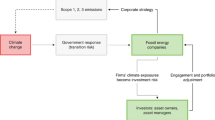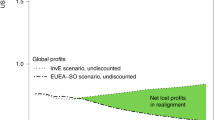Abstract
Investors and financial regulators are increasingly aware of climate-change risks. So far, most of the attention has fallen on whether controls on carbon emissions will strand the assets of fossil-fuel companies1,2. However, it is no less important to ask, what might be the impact of climate change itself on asset values? Here we show how a leading integrated assessment model can be used to estimate the impact of twenty-first-century climate change on the present market value of global financial assets. We find that the expected ‘climate value at risk’ (climate VaR) of global financial assets today is 1.8% along a business-as-usual emissions path. Taking a representative estimate of global financial assets, this amounts to US$2.5 trillion. However, much of the risk is in the tail. For example, the 99th percentile climate VaR is 16.9%, or US$24.2 trillion. These estimates would constitute a substantial write-down in the fundamental value of financial assets. Cutting emissions to limit warming to no more than 2 °C reduces the climate VaR by an expected 0.6 percentage points, and the 99th percentile reduction is 7.7 percentage points. Including mitigation costs, the present value of global financial assets is an expected 0.2% higher when warming is limited to no more than 2 °C, compared with business as usual. The 99th percentile is 9.1% higher. Limiting warming to no more than 2 °C makes financial sense to risk-neutral investors—and even more so to the risk averse.
This is a preview of subscription content, access via your institution
Access options
Subscribe to this journal
Receive 12 print issues and online access
$209.00 per year
only $17.42 per issue
Buy this article
- Purchase on Springer Link
- Instant access to full article PDF
Prices may be subject to local taxes which are calculated during checkout


Similar content being viewed by others
Change history
13 April 2016
In the version of this Letter originally published, a reference was mistakenly omitted. The new reference 15 — The Cost of Inaction: Recognising the Value at Risk from Climate Change (Economist Intelligence Unit, 2015) — is now cited in the sixth paragraph and subsequent references have been renumbered in all versions of the Letter.
References
McGlade, C. & Ekins, P. The geographical distribution of fossil fuels unused when limiting global warming to 2 °C. Nature 517, 187–190 (2015).
Carbon Tracker & Grantham Research Institute on Climate Change and the Environment Unburnable Carbon 2013: Wasted Capital and Stranded Assets (Carbon Tracker, 2013).
Arent, D. J. et al. in Climate Change 2014: Impacts, Adaptation, and Vulnerability. Part A: Global and Sectoral Aspects (eds Field, C. B. et al.) (Cambridge Univ. Press, 2014).
Stern, N. The Economics of Climate Change: The Stern Review (Cambridge Univ. Press, 2007).
Weitzman, M. L. GHG targets as insurance against catastrophic climate damages. J. Pub. Econ. Theory 14, 221–244 (2012).
Burke, M. B., Hsiang, S. M. & Miguel, E. Global non-linear effect of temperature on economic production. Nature 527, 235–239 (2015).
IPCC Managing the Risks of Extreme Events and Disasters to Advance Climate Change Adaptation. A Special Report of Working Groups I and II of the Intergovernmental Panel on Climate Change (Cambridge Univ. Press, 2012).
Stern, N. The structure of economic modeling of the potential impacts of climate change: grafting gross underestimation of risk onto already narrow science models. J. Econ. Lit. 51, 838–859 (2013).
Graff Zivin, J. & Neidell, M. Temperature and the allocation of time: implications for climate change. J. Labor Econ. 32, 1–26 (2014).
Climate Change Scenarios: Implications for Strategic Asset Allocation (Mercer, 2011).
Open letter to Finance Ministers in the Group of Seven (G-7) (Institutional Investors Group on Climate Change, 2015).
Carney, M. Breaking the Tragedy of the Horizon: Climate Change and Financial Stability (Bank of England, 2015).
Integrating Risks into the Financial System: The 1-in-100 Initiative Action Statement (United Nations, 2014).
Campbell, J. Y. & Viceira, L. M. Strategic Asset Allocation: Portfolio Choice for Long-Term Investors (Oxford Univ. Press, 2014).
The Cost of Inaction: Recognising the Value at Risk from Climate Change (Economist Intelligence Unit, 2015).
Covington, H. & Thamotheram, R. The Case for Forceful Stewardship Part 1: The Financial Risk from Global Warming (2015).
Kaldor, N. A model of economic growth. Econ. J. 67, 591–624 (1957).
Gollin, D. Getting Income Shares Right. J. Polit. Econ. 110, 458–474 (2002).
Modigliani, F. & Miller, M. The cost of capital, corporation finance and the theory of investment. Am. Econ. Rev. 48, 261–297 (1958).
Modigliani, F. & Miller, M. Corporate income taxes and the cost of capital: a correction. Am. Econ. Rev. 53, 433–443 (1963).
Arrow, K. J. et al. How should benefits and costs be discounted in an intergenerational context? Rev. Environ. Econ. Policy 8, 145–163 (2014).
Nordhaus, W. D. A Question of Balance: Weighing the Options on Global Warming Policies (Yale Univ. Press, 2008).
Dietz, S. & Stern, N. Endogenous growth, convexity of damages and climate risk: how Nordhaus’ framework supports deep cuts in carbon emissions. Econ. J. 125, 574–602 (2015).
Moyer, E., Woolley, M., Glotter, M. & Weisbach, D. A. Climate impacts on economic growth as drivers of uncertainty in the social cost of carbon. J. Legal Stud. 43, 401–425 (2014).
Anderson, B., Borgonovo, E., Galeotti, M. & Roson, R. Uncertainty in climate change modeling: can global sensitivity analysis be of help? Risk Anal. 34, 271–293 (2014).
Dietz, S. & Asheim, G. B. Climate policy under sustainable discounted utilitarianism. J. Environ. Econ. Manage. 63, 321–335 (2012).
Global Shadow Banking Monitoring Report 2014 (Financial Stability Board, 2014).
Fossil Fuel Divestment: A US$5 trillion Challenge (Bloomberg New Energy Finance, 2014); http://about.bnef.com/content/uploads/sites/4/2014/08/BNEF
Shiller, R. J. Do stock prices move too much to be justified by subsequent changes in dividends? Am. Econ. Rev. 71, 421–436 (1981).
CISL Unhedgeable Risk: How Climate Change Sentiment Impacts Investment (Cambridge Institute for Sustainability Leadership, 2015).
Dimson, E., Marsh, P. & Staunton, M. Equity Premiums Around the World (CFA Institute, 2011).
Maddison, A. The World Economy: A Millennial Perspective (Development Centre of the OECD, 2006).
Global Financial Stability Report 2011 (IMF, 2011).
Nordhaus, W. D. RICE-2010 and DICE-2010 Models (2012); http://www.econ.yale.edu/∼nordhaus/homepage/RICEmodels.htm
Nordhaus, W. D. & Boyer, J. Warming the World: Economic Models of Global Warming (MIT, 2000).
Dietz, S., Gollier, C. & Kessler, L. The Climate Beta (Centre for Climate Change Economics and Policy Working Paper 215 and Grantham Research Institute on Climate Change and the Environment, 2015).
IPCC Climate Change 2013: The Physical Science Basis (IPCC, 2013).
Acknowledgements
S.D. and A.B. would like to acknowledge the support of the UK’s Economic and Social Research Council (ESRC), and the Grantham Foundation for the Protection of the Environment. We are grateful for the invaluable advice of H. Covington and S. Waygood.
Author information
Authors and Affiliations
Contributions
S.D. led the project, from research design through modelling to writing the manuscript. A.B. helped design the research and draft the manuscript. P.G. helped design the research and run the model. C.D. also helped run the model.
Corresponding author
Ethics declarations
Competing interests
No competing financial interests have affected the conduct or results of this research. However, for the sake of transparency, the authors would like to make clear that they were employed by Vivid Economics Ltd during the production of this research. Vivid Economics Ltd is a London-based economics consultancy. Neither the authors nor the company stands to profit directly from this research.
Supplementary information
Supplementary Information
Supplementary Information (PDF 519 kb)
Rights and permissions
About this article
Cite this article
Dietz, S., Bowen, A., Dixon, C. et al. ‘Climate value at risk’ of global financial assets. Nature Clim Change 6, 676–679 (2016). https://doi.org/10.1038/nclimate2972
Received:
Accepted:
Published:
Issue Date:
DOI: https://doi.org/10.1038/nclimate2972
This article is cited by
-
A machine learning approach to rapidly project climate responses under a multitude of net-zero emission pathways
Communications Earth & Environment (2023)
-
Green preferences
Environment, Development and Sustainability (2023)
-
Near-term transition and longer-term physical climate risks of greenhouse gas emissions pathways
Nature Climate Change (2022)



